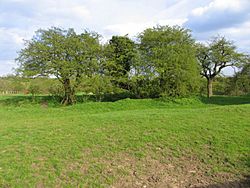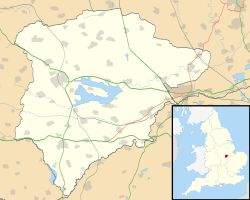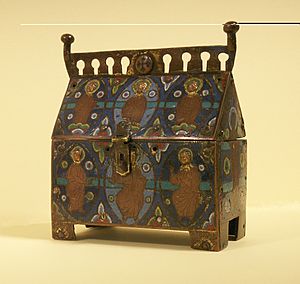Brooke Priory facts for kids

Ancient earthworks on the site of Brooke Priory
|
|
| Monastery information | |
|---|---|
| Order | Augustinian |
| Established | Before 1153 |
| Disestablished | 1535 |
| Mother house | Kenilworth Abbey |
| Dedicated to | Virgin Mary |
| Diocese | Diocese of Lincoln |
| People | |
| Founder(s) | Hugh de Ferrers |
| Site | |
| Location | Rutland, England |
| Coordinates | 52°38′46″N 0°45′09″W / 52.646066°N 0.752515°W |
Brooke Priory was a small home for Augustinian monks in Brooke, Rutland, England. It was like a smaller branch of a bigger monastery, St Mary's Abbey, Kenilworth.
Contents
Discovering Brooke Priory's Past
How Brooke Priory Started
Brooke Priory was founded by a man named Hugh de Ferrers. He was a powerful lord in the area. This happened before the year 1153. The priory was built near the River Gwash. It was dedicated to St Mary the Virgin.
Life at the Priory
Brooke Priory was always very small. It was only meant to support three canons. Canons were like monks who followed strict rules. The priory often had money problems. Many leaders, called priors, found it hard to manage. Being sent to Brooke was often seen as a punishment.
In 1298, a bishop wrote about the priory. He said it was falling apart. Its money was so badly managed. He worried the canons would soon have to beg for food.
The Priory's End
The last prior was Roger Harwell. He had disagreements with his bosses at Kenilworth Abbey. He wanted a large payment when he retired. But the abbey couldn't afford it.
In 1535, King Henry VIII decided to close many monasteries. This was called the Dissolution of the Monasteries. Prior Harwell told the king's officials that Brooke Priory was independent. He then closed it himself. This way, he got a yearly payment of £10 for himself. At that time, the priory was mostly in ruins. It had a small yearly income.
Prior Harwell's actions caused trouble. The Abbot of Kenilworth had promised to rent Brooke to a friend of Thomas Cromwell. The abbot begged Cromwell to help. But Brooke was never returned. The land was given to Anthony Cope in 1536.
After the priory closed, its name lived on. The land was sold in 1549 to Andrew Noel. He built Brooke House there. Today, only its dovecote and octagon lodge remain. Noel used this land to become powerful. He became a Member of Parliament. His family later became the Earls of Gainsborough.
Today, no buildings from the priory remain. But you can still see earthworks. These are changes in the ground. They might show where fishponds or other buildings were. Some old stones from the priory might be in a house called "Brooke Priory" today.
The Brooke Reliquary
The Brooke Reliquary is a special small box. It is also called a casket. It was made in the 1200s. It came from workshops in Limoges, France. People believe it once held a saint's relics. Relics are special objects linked to saints.
The reliquary was found around 1805. It had been hidden for many years. It was discovered during building work. This happened in the cellar of Priory House.
The reliquary is decorated with Limoges enamel. This is a type of colorful artwork. It uses shades of blue, red, yellow, and green. It shows images of Christ and two apostles or saints. The saints' robes were once covered in gold. But this gold has worn away over time. You can see the Brooke Reliquary today. It is on display at the Rutland County Museum in Oakham.




